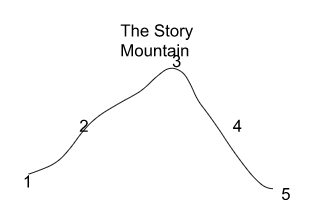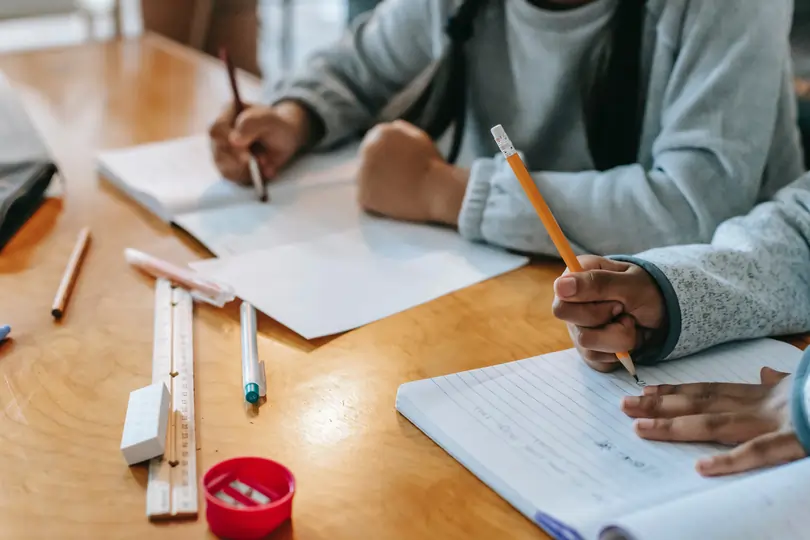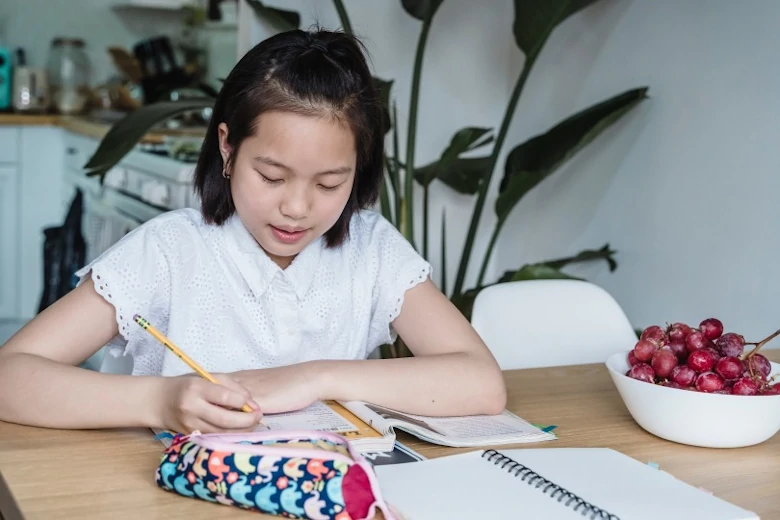Composition Structure
The word composition is derived from Latin and means “to put together”. In writing, the composition is the manner in which the writer puts together or structures the story or piece of writing. In this article, we will learn about the various aspects to keep in mind while writing any composition. We will cover the level of difficulty as per the Primary 6 English syllabus.
Composition structure is the way you can put together words and sentences to create meaningful work, such as a story, poem, or essay.
We will cover the following aspects of crafting a composition:
- Defining the overall structure through “Story Mountain”
- Building the climax of the story through the “FAST” method, and
- Building an impactful conclusion through the “MFHD” method
Let us look at each one in detail to understand them better. Ready?
Story Mountain
What is a story mountain? It is the structure for the whole story.
The various components of the story mountain are:
- Introduction
- Rising Action
- Climax
- Falling Action
- Resolution
Look at the diagram below. Can you tell why this technique is called a mountain?

Let us go through each of these components in detail so you can become great and proficient writers.
-
Introduction
It refers to how we present the topic to the readers.
-
Rising Action
In this section, we slowly take our readers through our composition by raising their curiosity and keeping them engaged in the story. We reveal the secrets one by one and move slowly through the maze of our story.
-
Climax
This is the most exciting part of our story. It is generally a problem that is presented in the story. This is the topmost part of our story mountain.
Do all stories need to have a problem/conflict? No, it is not necessary, but we see that all popular movies or drama series have a problem - an issue that drives the action. As humans, our minds like to solve problems. As such, the climax generally presses the problem like a fight between good v/s bad.
If our story is about our visit to the theme park, then the climax will be the most fun part of our visit; For example, the most exciting ride that we had.
-
Falling Action
In this section, we slowly try to take our readers toward the solution.
Here, the story starts to wind down and we move the readers from the mountain-top towards the descent. We slowly bring the readers back to a calm state.
We do not want our readers to have an abrupt ending. So, this is where we gradually take them towards the end.
-
Resolution
In this section, we reach the solution to the problem which was presented at the climax. Here we bring our readers to the final part where we offer a take-away from the story.
Now, let us try to put these various sections in the following story.
Example 1:
Take someone for a nice walk around your garden.
Solution:
Let us apply the various parts of the Story Mountain to this scenario.
- Introduction
A nice and warm welcome. You warmly welcome your guests to come and visit your garden. You show them the entrance and slowly take them inside. You will not be showing them a garbage dump and calling it your garden. You actually take them for a walk inside your garden. - Rising action
he excitement must build slowly. You do not reveal the best part of your garden right away. You want them to spend some time with you in your garden. So, you take them slowly through the various sections of the garden. This is called “build-up” or “delayed gratification”. - Climax
In the middle of the story, there must be a ‘wow’ moment. This is the most fun part of your story. In this scenario, it is the most beautiful part of your garden. You may have a fountain with certain lighting effects and other special features. - Falling Action
Here you slowly walk them to the end of your garden. Along the way, they will be wowed by the beauty of your fountain and also admire the path leading to the end of the garden. - Resolution
You say goodbye to them and send them on their way. You tell them to visit again. In this way, your readers will leave with pleasant thoughts of their visit to your garden, the flowers, the arches that they saw on the way in, the most beautiful fountain, and the similarly beautiful path out to the end. They will also remember your gracious tour and your good manners.
Heartbeat Method
This is another variant of the Story Mountain. In this method, we open the story with an explosion. This is generally not the whole of the climax but a peek into the climax. Then we slowly build the background and then take the readers through the full climax and then the wind-down and the conclusion.
-
Introduction
Here, it is not the entire climax but just a glimpse to get the readers hooked on the story.
To be able to fully appreciate the climax, the readers must know what is going on. They should know what happened before and they should also have an expectation of what comes next. Thus, here is just a trailer of the story.
-
Rising Action
Similar to what was mentioned earlier, here is where you build up the story. You slowly describe and develop the background of the explosive opening and give information to your readers about what happened before.
-
Climax
This is the full climax.
By now, your readers will be able to appreciate the climax much better as they have obtained background information. Reading the climax, they will grow some expectations about the future course of the story.
-
Falling Action
Now, they will have an expectation about the progression of the story.
-
Resolution
This is the resolution to the problem in the climax, aka the conclusion.
Example 2:
Title: The Strange Thing In The Woods.
From the sentences below, pick the one that serves best as a ‘rising action’.
- The thing got up slowly onto four metal legs, and we screamed as we ran for our lives.
- We collapsed onto the ground, overcome with exhaustion and glad that things were finally back to normal.
- I swallowed hard and turned to my companion. He nodded and together we began our trek into the woods. Today, we will find out what was inside.
Solution:
3
Example 3:
Which sentence below describes what a ‘falling action’ is?
- Things are at their most exciting with lots of details and action.
- The end of the story.
- Setting the scene and developing the characters.
- The most exciting part is over and we are bringing down the pace gradually.
Solution:
4
Example 4:
At the end of the story, you bid farewell to your reader. That said, it is alright to end the story with a cliffhanger - if done properly.
You must entice the reader to come back for more, without leaving them frustrated. Choose the best sentence to end the story on a cliffhanger:
- With trembling hands, I finally unfolded the letter…THE END
- I stared at the letter; after so many years, it was finally mine to read. THE END
- As I unfolded the letter, I did not know that a curse was activated, bringing new challenges into my life. THE END
- I decided to wait till the next morning to read the letter. THE END
Solution:
3
FAST
When you want to flesh out the climax of the story, you must include the following:
- Feeling
- Action
- Speech
- Thought
To flesh out means to build up more content in the climax of your story. Make the climax meatier. It should have a lot of details so that your reader can fully enjoy it by living every detail. This makes the climax very impactful.
Let us look at some examples to understand this better.
Example 5:
Read the excerpt of the climax scene below. Which part of FAST is highlighted?
The daggers swished past my head. Were they really trying to kill me? How did I get into this mess! I began to question not only their reasons but the missteps I took to have gotten myself into this situation.
- Feeling
- Action
- Speech
- Thought
Solution:
4
Example 6:
Which part of FAST is not present in the following excerpt?
The giant fish gave another powerful tug on the line.
“John, hold it strong! Keep the tension!” Rakesh yelled over the roaring waves. The ship rocked and tipped violently, and we strained to hold our positions. I wondered for a moment if the boat would break under all this stress. Was this fish truly worth the risk?
- Feeling
- Action
- Speech
- Thought
Solution:
1
Building The Conclusion (MFHD)
For the conclusion of our story, we choose from the following :
- Moral
- Feeling
- Hope
- Decision
Most of the time, we end with only one of these. An easy way to remember this is using the mnemonic -
My Father Had Donuts
A mnemonic is a pattern to help you remember something.
Example 7:
Which type of conclusion is the following?
That experience changed my life. I wish never to face something like that again. It made me emerge stronger, but it was definitely painful.
- Moral
- Feeling
- Hope
- Decision
Solution:
3
Example 8:
Which type of conclusion is the following?
From that point on, I vowed never to practice Green Magic again. It was definitely the most powerful form of magic, but I know now that I am not ready to pay the price for that kind of power.
- Moral
- Feeling
- Hope
- Decision
Solution:
4
Example 9:
Which type of conclusion is the following?
The incident taught me a very important lesson. In emergency situations, we should not panic or jump to conclusions. Instead, we ought to fall back on our training.
- Moral
- Feeling
- Hope
- Decision
Solution:
1
Example 10:
You wrote a story recounting your trip to a theme park. It was a happy day and you described all the awesome things you did. There was nothing out of the ordinary.
Which type of conclusion would NOT be appropriate for that story?
- Moral
- Feeling
- Hope
- Decision
Solution:
1
A Quick Recap
In this article, you learned how to frame your composition structure through Story Mountain. It includes the following sections:
- Introduction
- Rising Action
- Climax
- Falling Action
- Resolution
Once you have laid out the structure of your story, it is time to build upon the climax in great detail to pull in the readers and keep them hooked. This is done by using the FAST technique. It means including - Feeling, Action, Speech, and Thought to describe the climax.
You can leave an impactful ending to your story by concluding it with MFHD - Moral, Feeling, Hope, or Decision.
You are now ready to create impactful stories of your own. Write and share them with your parents and friends and have lots of fun.
 SG
SG  VN
VN 












